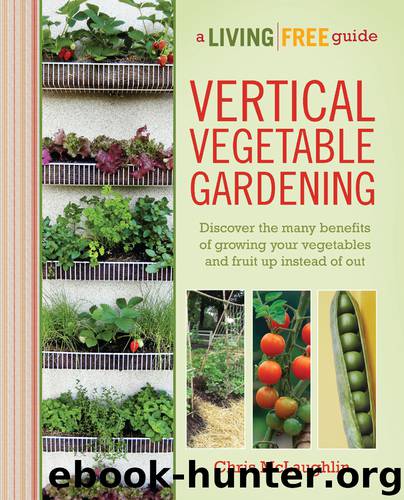Vertical Vegetable Gardening by Chris McLaughlin

Author:Chris McLaughlin [McLaughlin, Chris]
Language: eng
Format: epub
ISBN: 9781615643233
Publisher: DK Publishing
Published: 2012-12-31T16:00:00+00:00
Mulch Matters
A multitude of problems can be avoided by mulching your garden. Mulching is the second best thing you can do for your vegetable garden aside from composting (and compost can be used as a mulch, by the way; see Chapter 6 for more on compost). The praises of covering bare soil in landscaping, flower borders, and vegetable beds is sung by gardeners everywhere—and for good reason. Mulching saves you time, money, and effort. Adding just 1″ to 2″ of mulch helps to…
Retain water. Mulch shields the soil from the sun and drying winds, therefore cutting down on evaporation. Mulched vegetables need less watering time.
Control weeds. Weed seeds find it difficult to germinate when the light is blocked out by mulch. Even when a weed does start to sprout, mulch will often smother it before it gets a chance to grow up.
Prevent erosion. Mulch hugs organic matter (compost) and amendments close to the ground so plants aren’t washed away by water and rain.
Protect roots. Consistent soil temperatures provided by mulch protect plant roots and keep them cool for the summer.
Act as a disease barrier. Mulch, when added seasonally, adds a protective layer between plant leaves and last year’s fallen leaves or debris. This added layer is important because as water hits the ground, it normally splashes back up and hits plant leaves, potentially transferring bacteria to new growth.
Condition soil. Organic mulch eventually breaks down or composts, thereby building the soil. All life forms in the soil appreciate this benefit.
Numerous materials can be used as a mulch, and offer the same benefits no matter what type of garden or yard. For example, bark, rocks, and gravel are common inorganic mulches found under trees or in foundation landscaping. However, vegetable gardens are for the most part annual plants (there are exceptions, some herbs for instance) and the bed is often disturbed by harvesting, turning, and replanting seasonally and sometimes more often.
Download
This site does not store any files on its server. We only index and link to content provided by other sites. Please contact the content providers to delete copyright contents if any and email us, we'll remove relevant links or contents immediately.
Turbulence by E. J. Noyes(7935)
The Thirst by Nesbo Jo(6826)
Gerald's Game by Stephen King(4571)
Be in a Treehouse by Pete Nelson(3941)
Marijuana Grower's Handbook by Ed Rosenthal(3619)
The Sprouting Book by Ann Wigmore(3543)
The Red Files by Lee Winter(3367)
The Remains of the Day by Kazuo Ishiguro(3293)
Sharp Objects: A Novel by Gillian Flynn(2952)
Christian (The Protectors Book 1) by L. Ann Marie(2653)
Organic Mushroom Farming and Mycoremediation by Tradd Cotter(2626)
The Culinary Herbal by Susan Belsinger(2429)
Stone Building by Kevin Gardner(2348)
The Starter Garden Handbook by Alice Mary Alvrez(2281)
Lilac Girls by Martha Hall Kelly(2257)
The Unlikely Pilgrimage of Harold Fry by Rachel Joyce(2216)
The Lean Farm Guide to Growing Vegetables: More In-Depth Lean Techniques for Efficient Organic Production by Ben Hartman(2096)
Urban Farming by Thomas Fox(2061)
Backyard Woodland by Josh VanBrakle(1894)
